Acquiring a new horse can be an overwhelming and expensive process, especially with over 200 horse breeds to choose from today.
As such, it is important to ensure that you get your horse purchase right the first time around.
If you are considering buying the Westphalian horse, this article will help with your due diligence by informing you of everything there is to know about the breed.
Read on to learn with us all there is to know about the Westphalian horse breed.
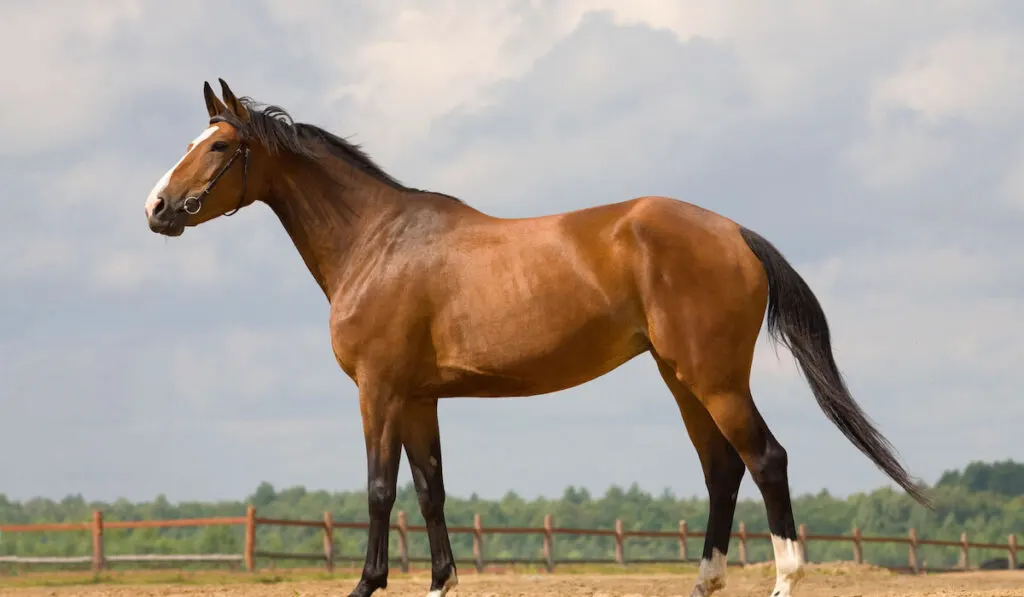
Table of Contents
The History of the Westphalian Horse
The Westphalian horse breed originated in the Westphalia region of Germany in the early 1800s.
A breeding farm in Warendorf bred the Westphalian horses for use in the cavalry and for the nobility. Eventually, the Trakehner became the preferred cavalry horse for the Prussian army.
However, there was a need for a heavier horse breed in the Rhein area to help with farm work.
To meet this demand, breeders crossed the Westphalian with heavier, cold-blooded breeds. The result was a light draught breed that could be driven or ridden.
With the coming of the 20th century, the demand shifted to horse breeds developed purely for riding.
This led to the incorporation of Hanoverian genes to lighten the Westphalian’s build.
Since the initial breed records were already destroyed at this point, breeders used their memory of the best stud and mare choices to best preserve the breed.
When breed inspections kicked off again in 1946, Westphalian breeders prioritized developing more athletic and reliable horses.
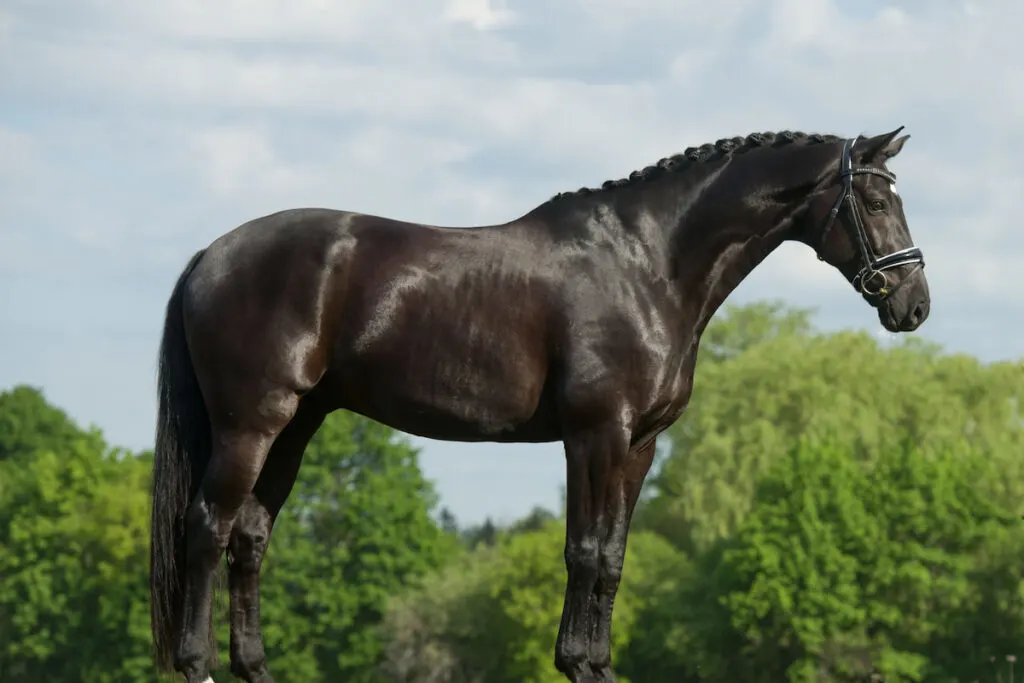
Characteristics of the Westphalian Horse
Westphalian Horse Conformation
Unlike other warmbloods, Westphalian horses have a lighter build with muscular hindquarters, well-angled shoulders, and perfectly set high necks.
These features help facilitate the breed’s remarkable freedom of movement.
However, even with all these, pinpointing the conformation of the Westphalian is still challenging because it is not bred for any specific roles or sports.
For this reason, one Westphalian horse can look utterly different from another.
Westphalian Horse Size
Westphalian horses typically stand from 15.2 to 17.2 hands.
This is thanks to draft influences that make the Westphalian taller than other warmblood horse breeds.
As far as weight goes, most Westphalian horses weigh anywhere from 1,000 to 1,300 pounds, but some stallions can weigh more than 1,300 pounds.
While the Westphalians share some similarities with the Hanoverian, it has a coarser build and lacks the refinement found in the Thoroughbred.
Westphalian Horse Colors
Westphalian horses are generally solid colored with chestnut, bay, gray, and black coat colors being the most common.
That being said, the Westphalian horse registry does not have any rules about coat color or markings. Therefore, it is not uncommon to find horses of other colors and patterns registered.
Keep in mind, however, that solid colors with minimal white markings on the feet and face are regarded as rare.
Lastly, all registered Westphalian horses should be branded with a shield symbol that has a “W” in the middle on their left hips. The brand is recognizable and helps identify the horse.
Westphalian Horse Temperament
Though highly athletic and robust, Westphalian horses have a meek and compliant temperament.
Besides making them quite easy to train, their easy-going demeanor makes the Westphalians desirable to work with by experts and novice horse riders.
That being said, beginner or casual riders should opt for other horse breeds because Westphalians may not be an ideal option for them —- they are more challenging to control because they are big movers.
Westphalian Horse Lifespan
With proper love and care, Westphalian horses will make great companions for 25 to 30 years since they do not have any major health problems.
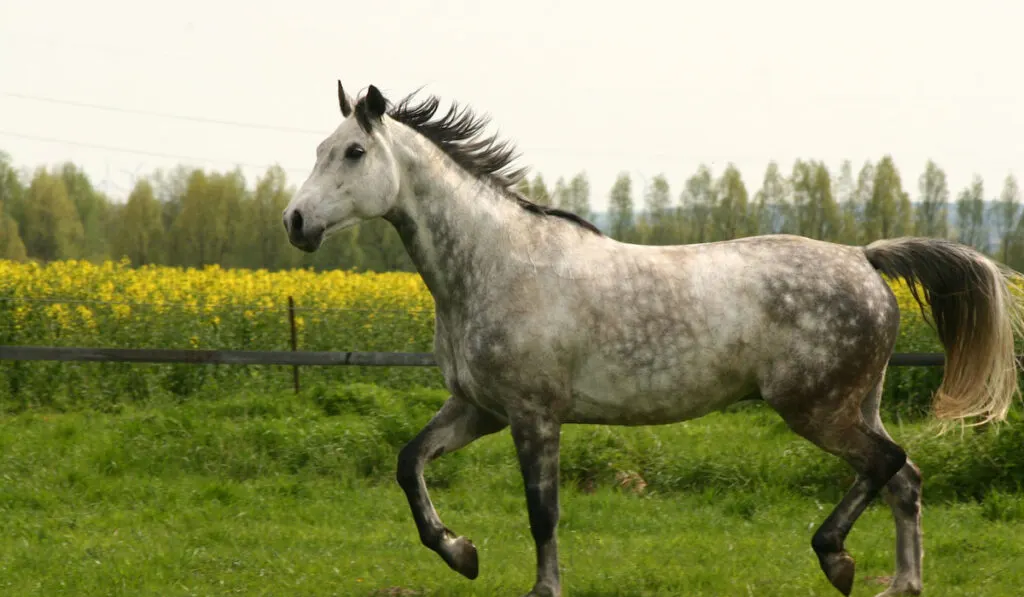
Westphalian Horse Uses
Modern Westphalian breeding focuses on developing athletic horses that are particularly rideable.
This is the primary reason why Westphalians are suitable for both experienced professional and amateur riders alike.
What’s more, it lends the Westphalians to the many disciplines they are used for today including:
- Dressage
- Show hunting
- Show jumping
The big strides and elastic gaits of Westphalian horses allow them to perform particularly well in show jumping and dressage.
Westphalian horses are also renowned for their work ethic — they are dedicated and willing to work, all the while maintaining an even temper and cooperation.
Overall, Westphalians attract a large variety of riders, and they are a joy to be around and work with.
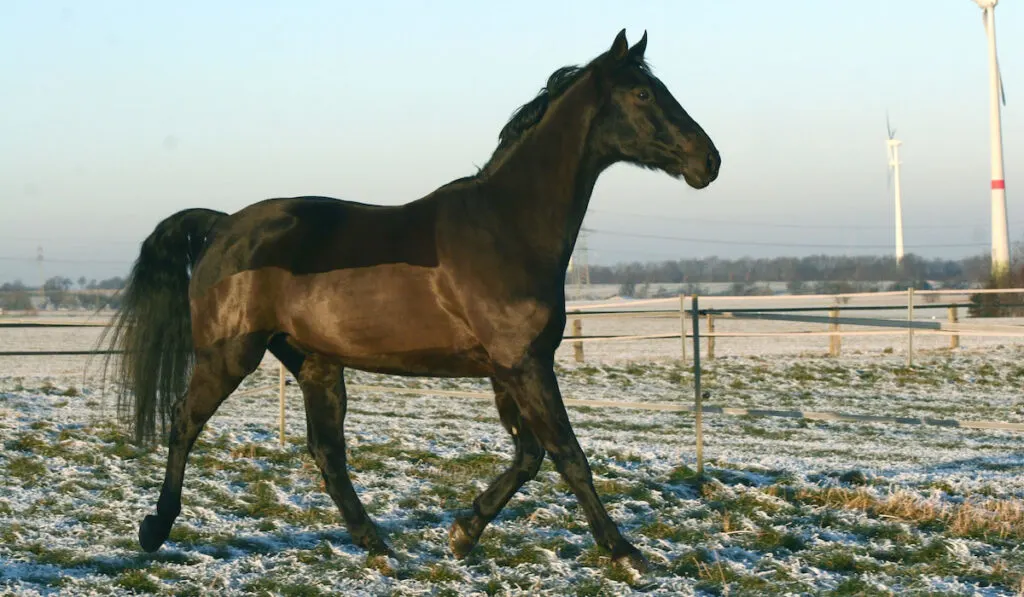
Caring for Westphalian Horses
Diet and Nutrition
As is the case with other horse breeds, a Westphalians’ diet mainly consists of forage like grass and hay.
Though this makes them easy to keep due to low maintenance, keep in mind that different Westphalian horses may have varying nutrition requirements.
For instance, Westphalians involved in rigorous work may need a food concentrate supplements to their regular forage feed.
That being said, mature Westphalians are large animals that need a large amount of forage or feed concentrate — that is, at least 25 pounds of hay or grass per day.
Grooming
Westphalian horses, like many animals, can benefit from regular grooming, especially if you keep them for show. Frequent combing of your Westphalians’ coats will guarantee a shiny and healthy look.
Regularly shampooing and conditioning your Westphalian horses’ manes and tails keeps them in good condition for showing since horses are shown with their tails and manes braided.
If anything, the manes become more manageable during braiding when they are regularly pulled.
Keep in mind that Westphalians’ grooming doesn’t end with their coats, manes, and tails.
It is also paramount to take care of their hooves and shoes to keep them in top shape and prevent injury.
Living Space
A large part of owning Westphalian horses is ensuring you have enough room for them to roam and graze outdoors as well as enough indoor room to rest and escape the elements.
The ideal outdoor grazing and roaming area for your horse should be ideally 2 to 3 acres.
This space, however, can be too small for multiple horses. Therefore, consider increasing it for every extra horse you have.
For safety reasons, be sure to fence your outdoor space to keep your horses in.
To ensure that the horses don’t jump over the fence or knock it down, erect the fence to a height of 5 feet high and above —- the higher you can go the better since Westphalians are excellent jumpers.
While the look of your indoor space is determined by the climate zone you are in, fully enclosed pole barns with adequate ventilation are a great fit for horses in almost any climate zone.
However, a three-sided barn may be the best option for your horse if you live in a warm climate.
Whichever setup you choose, it should have enough space for your horse to comfortably lie down, stand, or sit. In cases where you have more than one horse, there should be enough space for them to move away from each other.
The floor cover can be dirt, sawdust, or any other material that will help prevent slippage — a fall can cause adverse damage to your horse’s ligaments, and joints or even lead to a broken limb.
Lastly, ensure that there is always dry straw for your horse to use as bedding.
Offering extra straw and other bedding materials like blankets is a great way to keep the barn insulated and your horse warm during winter.
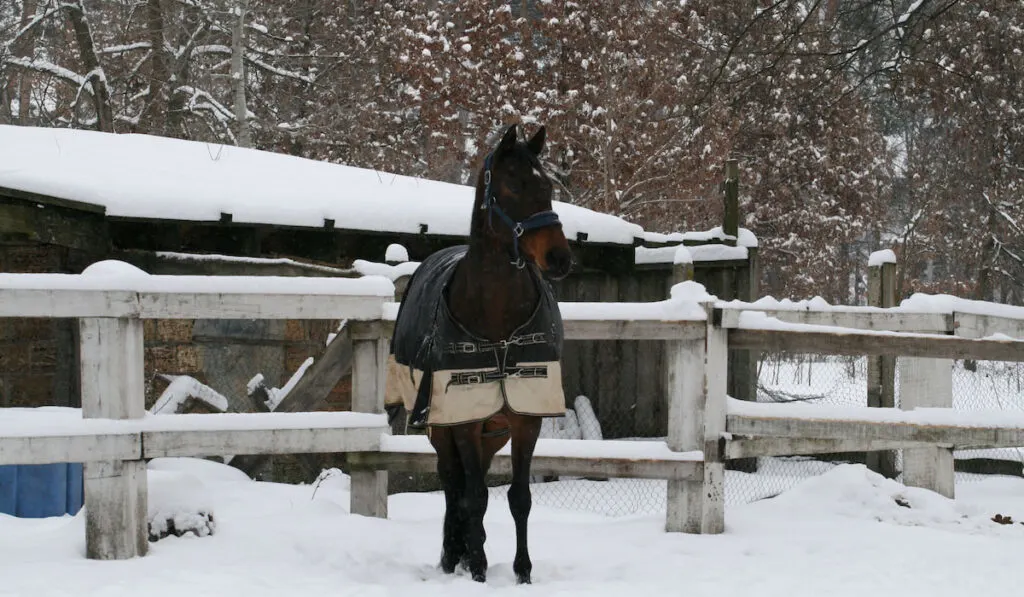
Westphalian Horses Common Health Issues
Westphalian horses are typically healthy. However, like other animals, they are prone to developing certain health issues that you should keep an eye out for.
Like Hanoverians, Westphalians are prone to developing osteochondrosis. Osteochondrosis is a condition that affects the bone and cartilage in horses’ joints.
Horses with this disease have abnormally formed cartilage that causes the joint bones to be weaker than in a normal or healthy joint.
Rapid growth, diet, exercise, genetics, and hormonal imbalance are all factors that can cause osteochondrosis to develop.
While osteochondrosis can affect any joint in a horse’s body, you will mostly see it in the:
- Fetlock or ankle
- Neck vertebrae
- Horse’s stifle or upper hind leg
- Hock (joints between the tarsal and tibia bones)
Some of the symptoms affected horses may present include swollen joints or reduced mobility.
Luckily, you can prevent the condition by offering your horses a balanced diet with the necessary vitamins and minerals.
Keep an eye out for over-exercising. While it is crucial for foal development, overdoing it can increase the chances of developing osteochondrosis.
Also, consult your equine vet for professional guidance.
Keep in mind that osteochondrosis can in some cases lead to navicular pain — a severe hoof condition that requires critical care to ensure that your horse is comfortable.
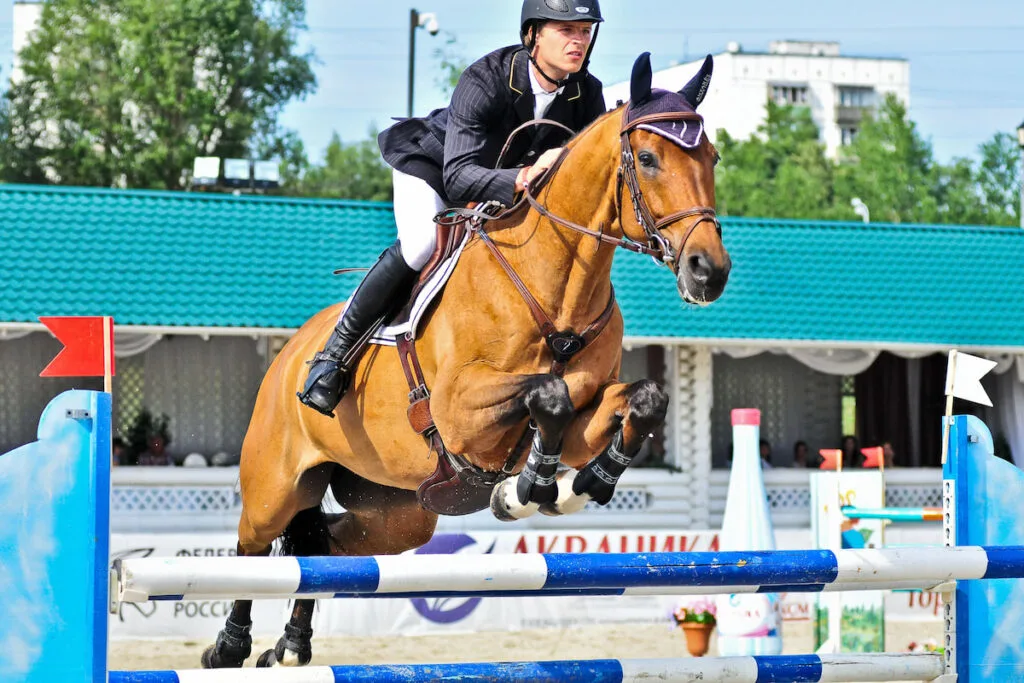
Famous Westphalian Horses
Because Westphalians are multi-purpose horses, it is not unusual that they are quite common in competitions.
As a result, several notable famous horses have participated in Olympic competitions. They include:
- Rembrandt: The gelding won gold in dressage in the 1990 World Championships and another in the1992 Olympics.
- Ahlerich: He competed in the Olympics and won individual and team dressage gold medals in 1984 and 1988.
- Farbenfroh: He was in the German dressage team that won a team gold during the 2000 Olympics.
Final Thoughts
Versatility doesn’t get any better than the Westphalian horse breed.
Whether you are looking for dressage, driving, or show jumping horse for entry or advanced-level competition, you can never go wrong with a Westphalian.
The best part is that they are docile and friendly, making them great riding partners for beginners and professionals.
Resources
- https://www.amnh.org/explore/ology/zoology/all-about-horses
- https://en.wikipedia.org/wiki/Rembrandt_(horse)
- https://en.wikipedia.org/wiki/Ahlerich
- https://www.fei.org/horse/104DI60
- https://www.fei.org/horse/104DI60
- https://en.wikipedia.org/wiki/Westphalian_horse
- https://www.thesprucepets.com/westphalian-horse-breed-profile-4801600
- https://www.horseillustrated.com/horse-breeds-horse-breed-articles-the-westphalian
- https://petkeen.com/westphalian-horses
- https://www.horsebreedspictures.com/westphalian-horse.asp
- https://karinabrez.com/blogs/news/westphalian-horse-origin-and-characteristics
- https://www.horseillustrated.com/horse-breeds-horse-breed-articles-the-westphalian
- https://www.petguide.com/breeds/horse/westphalian-horse/

